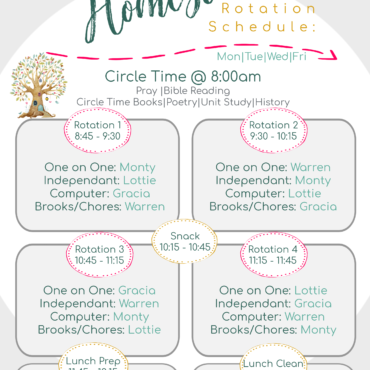If you would have told me 15 years ago that one day I would be homeschooling teenagers, elementary kids, potty training a toddler and still breastfeeding a baby, I would have never believed you. Buying deodorant and diapers on the same grocery trip would have never crossed my mind! And yet here we are, 7 kids later and what seems like a million personalities and stages all happening at the exact same time.
Homeschooling can be such a rewarding experience for families with babies and teenagers under one roof, but that doesn’t mean it comes without a TON of challenges. Amidst the beautiful chaos that comes with having children of many ages, homeschooling offers unique opportunities for building strong relationships and imparting valuable skills. However, it’s crucial to strike a balance between schoolwork, childcare, housework, and quality time with each child. Finding balance has not been something that has come naturally to me. I am not the least bit unfamiliar with hungry babies screaming during algebra, toddlers and preschoolers interrupting every single read-aloud, or drastically shrinking down the work load just to “get through” those long, drawn out days. And yet now that my youngest has just turned one, I look back and see that somehow during all of that craziness we still have kids that love to read, math curriculums that were still completed, creative and responsible teenagers that are able to complete almost anything they put their minds too, and beautiful relationships that have grown between them all. If you are feeling lost in the chaos, start by reminding yourself of all of the beautiful things that come with homeschooling a large family:
1. Strong Sibling Bonds: Homeschooling allows siblings of different ages to spend more time together, fostering deep and meaningful relationships that can last a lifetime.
2. Mentorship and Responsibility: Older siblings can develop leadership skills by assisting with the care and education of younger siblings, promoting responsibility and empathy.
3. Enhanced Learning Opportunities: Younger siblings benefit from exposure to advanced concepts and activities, as they observe and learn from their older siblings during homeschooling sessions.
4. Individualized Attention: Having older children to alternate helping with the littles can allow parents to find breaks so that they can meet the unique needs of each child, ensuring a personalized and effective learning experience.
5. Increased Flexibility: Homeschooling allows families to create a schedule that works best for their specific circumstances, accommodating the needs of both babies and teenagers.
Throughout all of these blessed but definitely crazy years, I feel that we have finally created somewhat of a healthy balance and rhythm. With many trials and errors, we have slowly found our groove with our days. We know which kids flourish in different areas. We know which kids we need to pay extra attention to with finding their own moments of solitude amongst the busyness. We know which kids love helping in the kitchen and which kids would rather take their younger sibling on a hike while I spend time one-on-one with someone else. Below are a few of the things I have learned over the years that has really helped me find balance in my days.
1. Establish a Flexible Routine: Create a loose daily schedule that accounts for everyone’s needs and preferences, allowing for adjustments as required.
In our home, the kids always loosely know what comes next. We separate our mornings into blocks that run approx. 30-60 minutes. During each of these blocks, we separate the school age kids into the following categories:
– One-on-one learning time with mom
– Individual bookwork time
– Computer and online learning
– Hanging out with the younger siblings
By alternating our school time this way, each kid gets time with their siblings to play and be creative, time to work independently, quiet and unassisted time at the computer, and then quality time with me for the actual teaching or specific things that they are needing help with. I have found that by organizing our days this way, we are all able to complete what needs to be done in our days. We are mostly able to stay on task without the older kids wondering what to do next while they wait for my schedule to open up — which honestly rarely does if I do not take the time to pencil it in! You made need to do something entirely different from me, and chances are that your rhythm will continue to evolve as the years (or sometimes weeks) move along. But having a loose routine for the kids to follow will make all of the difference as to how your days flow.
2. Train them well in their Independent Learning: Encourage older children to engage in self-directed learning, empowering them to manage their time effectively while you attend to the younger ones.
I have high expectations for the times when my kids work independently. When I tell them at the beginning of the day what I expect them to get done during their individual time, I fully expect it to get done. Something you may have noticed with your homeschooled kids is how much they LOVE the times when their work is all caught up, chores are done, and they can spend the rest of their days being creative or working on whatever their heart desires. In my home, the kids know that if they do not finish what I had laid out for them at the start of the day by the time their free time rolls around, that they now need to spend the most precious free hours of their day catching up. It’s actually more simple than you think. (Obviously exceptions are made when they are struggling). The key here is to train them SLOWLY with working well and productively during their independent times. This does not just happen overnight and you will definitely find that some of your kids need A LOT MORE training than others. For some of your kids you might need to do the majority of their schoolwork during your one-on-one, and leave them with simple tasks during their individual time until they slowly gain enough confidence to add more and more to their alone time. For other kids, you may find that they thrive and actually learn to prefer their individual learning time… that will just depend on their personalities.
3. Group Activities: Plan learning activities that involve all of the kids, fostering cooperation and teamwork, such as science experiments, art projects, or nature hikes.
Use your non-school days or your afternoons to play around with science projects or work on projects outside together. You will be surprised how much they learn when you take on challenges together. In the past, we have also deeply valued our morning time together. We work hard to meet together in the morning for at least a quick read aloud, a devotional, or a ‘day in review’ type of conversation. I always have high expectations for the beautiful things we will do during with our morning time together but there are many, MANY days when we have found that less is more. On the days that everything runs smoothly, I always have many books and resources close by in a basket that we can read and study together. But on the days when the littles are just too demanding, we quickly move into our block schedule. This is the season we are in now and I know that in the following months and years as they all grow up a little, that our morning time will slowly become even more. But for now, I am choosing to trust God with the process of raising all of these beautiful humans he has assigned to my care, knowing that seasons come and seasons go.
4. Babywearing: If needed, utilize baby carriers or slings to keep your little one close while engaging in hands-on activities with older children, promoting bonding and flexibility.
5. Create Child-Friendly Spaces: Designate areas in your home where younger children can safely play and explore while you work with older siblings, minimizing distractions.
For us this means having many small areas of the home divided into focused and organized spaces so that they can all spread out without feeling we are constantly stepping on each others toes! I have never been a huge fan of most toys. I feel they cause clutter, chaos, upkeep to maintain (think batteries and missing wheels), and just generally don’t promote the type of free play that we want to instil in our kids. I love toys that come in collections: puzzles, legos, calico critters, farm toys, wooden blocks, and cars and roads for those long winter or rain days. I also like to have a few areas where they can work on a computer or watch a show or documentary, and then a few areas that are cozy for reading or just free play. We spread out our toys in different spaces throughout the house as oppose to having one huge giant toy room. So when our 4 year old wants to play lego, he gets to have quiet time in our bedroom where we we store the collection in the bottom of my husbands closet! Or when the girls want to run wild with Calico critters, they play together in a bedroom where they have room to stretch out an entire village and leave it setup for days without the fear of their younger siblings pulling apart all of the little pieces. By spreading out the activities and spaces as opposed to having it all piled up in one specific space, you will be able to separate the learning from the play when needed, and also keep things a little more streamlined and easier to cleanup.
6. Utilize Naptime or Quiet Time in the Afternoon: Use these quieter periods of time by focusing on more challenging lessons or completing household chores, or maybe just catching up on much needed rest!
Train your kids that from the time they start to give up their afternoon nap, that the entire home is expected to have quiet time. Designate 1-2 hours in the afternoon where the kiddos can either play quietly in their spaces, watch a family movie, read, or play outside. Even my teenagers know that for a few hours in the afternoon, they are expected to be quiet and self sufficient.
7. Encourage Cooperative Learning: Promote sibling collaboration by assigning older children the responsibility of teaching specific subjects or concepts to their younger siblings.
One of the coolest (and sometimes scariest) things about homeschooling is watching the influence that the older kids have over their younger siblings! Nothing is more exciting than watching your 10 year cuddle the younger ones on the sofa while reading them a story. Utilize this skill as much as you can and specifically plan certain ideas or activities where your older children can facilitate the learning for the younger ones.
8. Prioritize Quality Time: As touched upon earlier, dedicate individual time with each child to nurture their interests, engage in meaningful conversations, and build a strong parent-child bond.
One of the things we do aside from one-one-one teaching is take turns including kids on certain errands, and then tie in something additional while we are out and about. Maybe it’s the library, or a trip to the hobby store, or just letting them pick out something special from the grocery store. Having that one-on-one time where they can chat alone with you can create such a special bond, and allow them to fully have your attention.
Homeschooling with both babies and teenagers in the house presents a unique set of challenges, but the benefits for siblings of different ages are invaluable. By striking a balance between schoolwork, childcare, housework, and quality time, you can create a harmonious and enriching homeschooling environment. Embrace the beautiful chaos, cherish the relationships your children develop, and celebrate the continuous learning that takes place within your homeschooling journey — even when you might think it is all falling apart!








Add Comment